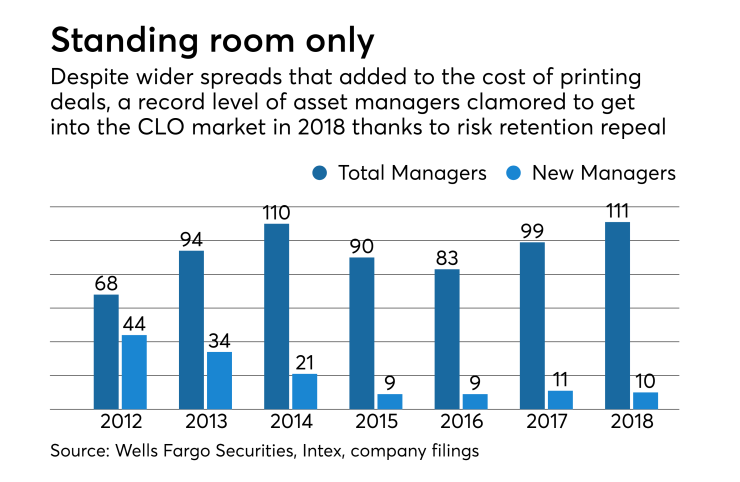After widening for the past eight months amid heavy supply and concerns about slowing economic growth, spreads on CLO securities may be set to narrow, according to Wells Fargo.
In a report published Monday, analyst David Preston cited ongoing strong demand for collateralized loan obligations as well as the experience of previous market sell-off and subsequent recovery two years ago. He expects average spreads on new issues to tighten across most of the capital, from the senior AAA rated notes down through BB notes. (The report does not speak to spreads on B notes, which are rare.)
"While calling the bottom is never easy, we think we are closer to the cyclical wides than not, and we think spreads are more likely to go tighter than wider in the first quarter," the report states.
Wells projects that spreads on AAA notes, currently average 128 basis points, will narrow to 125 basis points above three-month Libor. The average AA note spread could narrow to 175 basis points from the existing 200 basis point average, and both A and BBB could narrow 55 basis points (to 245 and 345 basis points, respectively) at the end of March. Average spreads on BB notes should narrow to 630 basis points from 700.

This view is based on the previous period of significant CLO spread widening, which took place from the middle of 2015 and early 2016. At that time, the market was negatively impacted by volatility in the energy markets, which raised concerns about the credit quality of assets in CLO portfolios - similar to today’s worries over CLO's retail exposure. After reaching a wide of 155 basis points over Libor in February 2016, AAA spreads started contracting, moving in to 100 basis points by April 2018. Wells believes the CLO market is in line for a similar narrowing trend in the first quarter of 2019.
On a percentage basis, BB spreads have widened significantly less in 2018 than in 2015; AA and BBB spreads have widened marginally less in 2018 than in 2015, and AAA and A spreads have widened more this time than in 2015. "This would indicate that A’s are significantly oversold this time around, although A’s also were tighter eight months ago since they were arguably the richest part of the capital stack from much of 2017."
Not only are CLO valuations currently attractive, relative to historical levels; Wells also does not see a risk of failing coverage tests or CLO downgrades in the next nine months.
Nevertheless, Preston concedes that "it is difficult to see a scenario in which CLO spreads tighten while the loan market continues to see significant outflows, and stocks are trading down."
Since November, investors have withdrawn $17 billion from leveraged-loan funds - the other major buyer of loans - driven by recalibrated rate-rise expectations and “a steady drumbeat of stories about declining fundamentals in corporate credit generally, and bank loans specifically,” the report notes.
While changing rate outlooks are also a factor in CLO spread widening, “near-term fundamentals are relatively healthy” for CLOs," according to Preston. Even with projected slower economic growth, loan issuers are still posting healthy earnings growth, and record high interest coverage.”
"However, at some point, since we believe this is a largely technically driven sell-off, we believe a lack of primary supply and cheap valuations will attract investors, which can lead to a quick turnaround in spreads," the report states.
Wells believes that a large pipeline of primary deals is awaiting a first-quarter launch out of warehouse lines, which will occur as volatility in loans diminishes and spreads stabilize. That would also replicate the first quarter of 2016. That year, only three deals priced before mid-February, after which 17 more priced through the remainder of the first quarter.
However, if the current environment persists, wider spreads and a more volatile market may also drive issuance of static deals, deals with shorter reinvestment periods, or deals in which the manager opts to "print and sprint."





